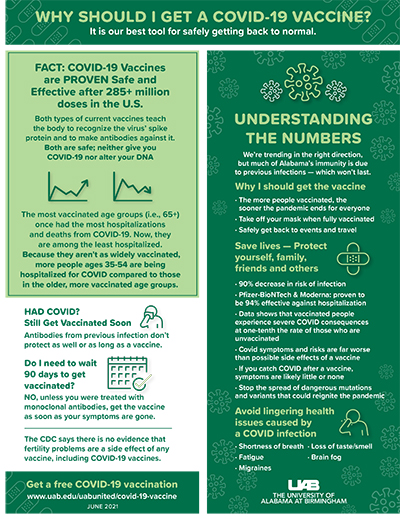Editor's Note: The information published in this story is accurate at the time of publication. Always refer to uab.edu/uabunited for UAB's current guidelines and recommendations relating to COVID-19.
Imagine driving on the road alongside a hill or mountain when a rock suddenly appears in front of you. Or driving on an Alabama country road at dusk, and a deer darts from the brush and runs in front of your car. Or having someone change lanes quickly in front of you during rush hour only to slam on their brakes, leaving you vulnerable to ramming into the back of their vehicle.
Published, peer-reviewed research has shown COVID-19 vaccinations to be safe and effective. Read more about the safety and efficacy of these vaccines.
• Pfizer-BioNTech mRNA vaccine research
• Moderna vaccine research
• Johnson & Johnson vaccine research
What keeps any of us safe in these scenarios — besides good brakes, some slick driving skill and, perhaps, a little luck — is a seat belt.
It is the perfect go-to analogy to describe the risk some 70 percent of Alabamians are taking right now when it comes to getting the COVID-19 vaccine, says Suzanne Judd, Ph.D., an epidemiologist in UAB’s School of Public Health. Specifically, it addresses those who are trusting everyone else to get the vaccine so they do not have to do so themselves.
“Relying on other people around you to get vaccinated to keep immunity levels high and protect you from COVID is like driving without a seatbelt and trusting that other drivers won’t hit you, animals won’t jump in front of your car and your tire won’t blow out,” Judd said. “The seatbelt keeps you safe when unforeseen things happen on the road. The vaccine keeps you safe when unforeseen things happen with the virus.”
“With only 29.4 percent of Alabama’s population fully vaccinated, we’re playing a dangerous game of chicken with COVID-19’s continued impact on our future. That’s not the road we need to travel on if we want to put an end to this pandemic.”
Indeed, according to the latest CDC statistics, 1.45 million Alabamians — 29.5 percent — are fully vaccinated. For comparison, more than 141 million Americans are fully vaccinated, or 43.0 percent of the population.
When we examine what is happening with the virus currently, it is easy to see why many are not seeking vaccines.
The United States is averaging about 14,500 daily infections over the past week. The number of positive cases has now dropped to less than five people per 100,000 each day in the state of Alabama, which keeps us in the green zone (good) and out of the red zone (bad). UAB Hospital was caring for only 11 COVID-positive patients on June 6 — its lowest number since it received its first patient on March 22, 2020, when six patients were hospitalized with SARS-CoV-2 — and has averaged caring for 22 active COVID-positive patients for the past month.
You can schedule an appointment for a vaccination through UAB Medicine’s Injection Clinic, located at 539 Richard Arrington Jr. Blvd. Walk-ins are accepted too.
Masks are no longer advised by the CDC for those who are fully vaccinated, which is a great thing.
But the average daily United States COVID-19 vaccination rate has dropped by more than 66 percent from its peak in April, according to the CDC. And, for Alabama, that pesky 29.5 percent number of fully vaccinated residents still lingers, and it concerns Judd.
“Groups of people with vaccination rates lower than 50 percent are at extremely high risk of contracting SARS-CoV-2,” Judd said. “Without immunity to SARS-CoV-2, the risk of death or hospitalization following COVID infection is exactly the same as it was last year. The only thing that has decreased is the likelihood of getting a COVID infection. But in people without immunity, the virus is still very dangerous.”
So, what does this mean moving forward? What does it mean if Alabama does not reach the Alabama Department of Public Health’s goal of 70 percent vaccination?
“All of these numbers mean we are moving out of pandemic COVID management and into endemic COVID management,” Judd said. “Since, as a state, we don’t have enough people vaccinated, we are unprepared to eradicate SARS-CoV-2, which means we will continue to have regular outbreaks or epidemics. In epidemiology, the word epidemic really means when a disease occurs at a higher rate than is normal. COVID is now going to be a part of the new normal. We will very likely continue to see spikes in the future, which will lead to higher hospitalization rates and deaths.”
In this phase of COVID management, Judd says the key factors she will be tracking include:

- What is the normal or manageable rate of SARS-CoV-2 infection?
- What do we do when the rate of SARS-CoV-2 infection goes above normal?
- Does the vaccine protect against variants that will continue to emerge?
- Does immunity fade? Are booster shots needed?
- Is the virulence or severity of the virus changing?
- In which populations are cases occurring?
Michael Saag, M.D., professor with UAB’s Division of Infectious Diseases, is imploring those who have not received the vaccine to reexamine their reasons and reconsider their stance.
“We should not be talking about herd immunity; we should be talking about vaccinations and protecting ourselves,” Saag said. “These vaccines work, and they work extremely well. The vaccine is our escape from the pandemic. If we didn’t have these vaccines come to us in the way that they did — with the efficacy and safety they have — we would still be in the December, January, February epidemic right now. We should celebrate where we are, but we also should take on the responsibility of protecting ourselves by getting vaccinated and taking advantage of this medical breakthrough.”